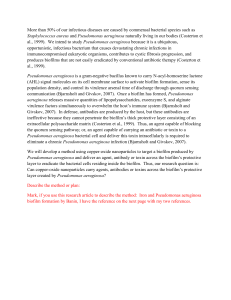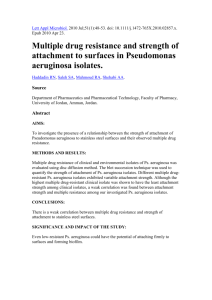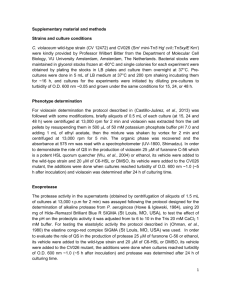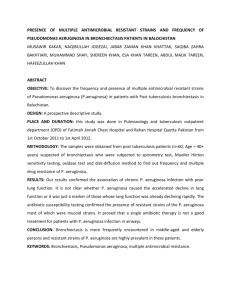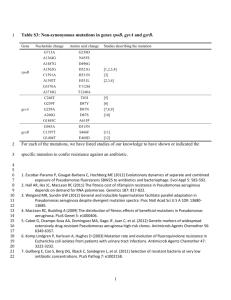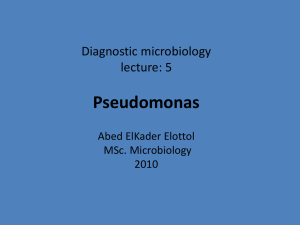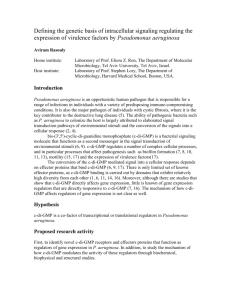Abstract wide variety of environments is due in part to its... genetic versatility, which contributes significantly ...
advertisement
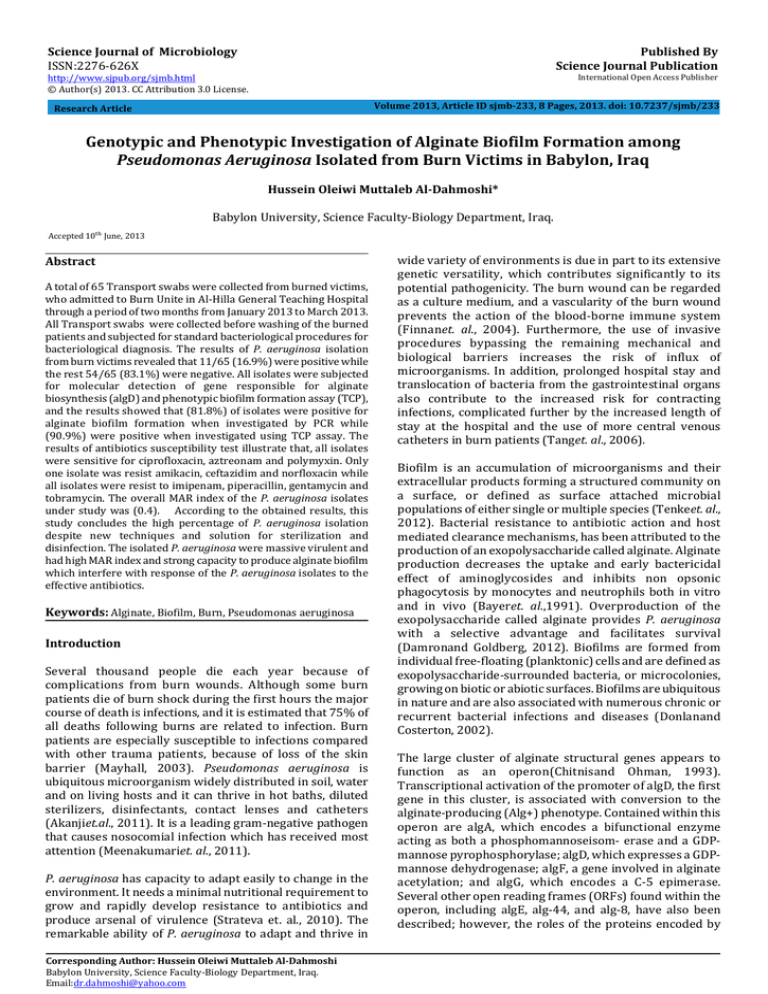
Published By Science Journal Publication Science Journal of Microbiology ISSN:2276-626X International Open Access Publisher http://www.sjpub.org/sjmb.html © Author(s) 2013. CC Attribution 3.0 License. Volume 2013, Article ID sjmb-233, 8 Pages, 2013. doi: 10.7237/sjmb/233 Research Article Genotypic and Phenotypic Investigation of Alginate Biofilm Formation among Pseudomonas Aeruginosa Isolated from Burn Victims in Babylon, Iraq Hussein Oleiwi Muttaleb Al-Dahmoshi* Babylon University, Science Faculty-Biology Department, Iraq. Accepted 10�� June, 2013 Abstract A total of 65 Transport swabs were collected from burned victims, who admitted to Burn Unite in Al-Hilla General Teaching Hospital through a period of two months from January 2013 to March 2013. All Transport swabs were collected before washing of the burned patients and subjected for standard bacteriological procedures for bacteriological diagnosis. The results of P. aeruginosa isolation from burn victims revealed that 11/65 (16.9%) were positive while the rest 54/65 (83.1%) were negative. All isolates were subjected for molecular detection of gene responsible for alginate biosynthesis (algD) and phenotypic biofilm formation assay (TCP), and the results showed that (81.8%) of isolates were positive for alginate biofilm formation when investigated by PCR while (90.9%) were positive when investigated using TCP assay. The results of antibiotics susceptibility test illustrate that, all isolates were sensitive for ciprofloxacin, aztreonam and polymyxin. Only one isolate was resist amikacin, ceftazidim and norfloxacin while all isolates were resist to imipenam, piperacillin, gentamycin and tobramycin. The overall MAR index of the P. aeruginosa isolates under study was (0.4). According to the obtained results, this study concludes the high percentage of P. aeruginosa isolation despite new techniques and solution for sterilization and disinfection. The isolated P. aeruginosa were massive virulent and had high MAR index and strong capacity to produce alginate biofilm which interfere with response of the P. aeruginosa isolates to the effective antibiotics. Keywords: Alginate, Biofilm, Burn, Pseudomonas aeruginosa Introduction Several thousand people die each year because of complications from burn wounds. Although some burn patients die of burn shock during the first hours the major course of death is infections, and it is estimated that 75% of all deaths following burns are related to infection. Burn patients are especially susceptible to infections compared with other trauma patients, because of loss of the skin barrier (Mayhall, 2003). Pseudomonas aeruginosa is ubiquitous microorganism widely distributed in soil, water and on living hosts and it can thrive in hot baths, diluted sterilizers, disinfectants, contact lenses and catheters (Akanjiet.al., 2011). It is a leading gram-negative pathogen that causes nosocomial infection which has received most attention (Meenakumariet. al., 2011). P. aeruginosa has capacity to adapt easily to change in the environment. It needs a minimal nutritional requirement to grow and rapidly develop resistance to antibiotics and produce arsenal of virulence (Strateva et. al., 2010). The remarkable ability of P. aeruginosa to adapt and thrive in Corresponding Author: Hussein Oleiwi Muttaleb Al-Dahmoshi Babylon University, Science Faculty-Biology Department, Iraq. Email:dr.dahmoshi@yahoo.com wide variety of environments is due in part to its extensive genetic versatility, which contributes significantly to its potential pathogenicity. The burn wound can be regarded as a culture medium, and a vascularity of the burn wound prevents the action of the blood-borne immune system (Finnanet. al., 2004). Furthermore, the use of invasive procedures bypassing the remaining mechanical and biological barriers increases the risk of influx of microorganisms. In addition, prolonged hospital stay and translocation of bacteria from the gastrointestinal organs also contribute to the increased risk for contracting infections, complicated further by the increased length of stay at the hospital and the use of more central venous catheters in burn patients (Tanget. al., 2006). Biofilm is an accumulation of microorganisms and their extracellular products forming a structured community on a surface, or defined as surface attached microbial populations of either single or multiple species (Tenkeet. al., 2012). Bacterial resistance to antibiotic action and host mediated clearance mechanisms, has been attributed to the production of an exopolysaccharide called alginate. Alginate production decreases the uptake and early bactericidal effect of aminoglycosides and inhibits non opsonic phagocytosis by monocytes and neutrophils both in vitro and in vivo (Bayeret. al.,1991). Overproduction of the exopolysaccharide called alginate provides P. aeruginosa with a selective advantage and facilitates survival (Damronand Goldberg, 2012). Biofilms are formed from individual free-floating (planktonic) cells and are defined as exopolysaccharide-surrounded bacteria, or microcolonies, growing on biotic or abiotic surfaces. Biofilms are ubiquitous in nature and are also associated with numerous chronic or recurrent bacterial infections and diseases (Donlanand Costerton, 2002). The large cluster of alginate structural genes appears to function as an operon(Chitnisand Ohman, 1993). Transcriptional activation of the promoter of algD, the first gene in this cluster, is associated with conversion to the alginate-producing (Alg+) phenotype. Contained within this operon are algA, which encodes a bifunctional enzyme acting as both a phosphomannoseisom- erase and a GDPmannose pyrophosphorylase; algD, which expresses a GDPmannose dehydrogenase; algF, a gene involved in alginate acetylation; and algG, which encodes a C-5 epimerase. Several other open reading frames (ORFs) found within the operon, including algE, alg-44, and alg-8, have also been described; however, the roles of the proteins encoded by Science Journal of Microbiology (ISSN:2276-626X ) these genes in alginate biosynthesis are unknown (Maharajet. al., 19930. Multidrug-resistant (MDR) strains of P. aeruginosa are often isolated from hospitalized patients particularly those in the intensive care unit (ICU). Thus, infections caused by P. aeruginosa are particularly problematic because the organism is inherently resistant to many drug classes and is able to acquire resistance to all effective antimicrobial drugs(Gad et. al., 2007).The multiple antibiotics resistance index MAR index was determined for each isolate by dividing the number of antibiotics against which the isolate showed resistant over the total number of antibiotics tested. MAR index higher than 0.3 indicates wide use of this antibiotic in the originating environment of this isolate (Subramaniand Vignesh, 2012). Antimicrobial agents effective against planktonic bacteria frequently fail to eradicate bacterial biofilms. The problem is that choosing of antibiotics is based on bacterial cultures derived from planktonic bacteria which differ in behavior and in phenotypic form from bacteria in biofilm. The failure of antimicrobial agents to treat biofilms has been associated with a variety of mechanisms:1-agents often fail to penetrate the full depth of the biofilm (extrinsic resistance), 2organisms in the biofilm grow more slowly; therefore, they are more resistant to antimicrobial agents that require active growth, 3-antimicrobial binding proteins are poorly expressed in these bacteria, 4-bacteria within a biofilm activate many genes that alter the cell envelope, the molecular targets, and the susceptibility to antimicrobial agents (intrinsic resistance), 5-bacteria in a biofilm can survive in the presence of antimicrobial agents at a concentration 1,000–1,500 times higher than the concentration needed to kill planktonic cells of the same species (Tenke, 2006). Aminoglycosides and beta-lactam antibiotics were showed to be able to prevent the formation of “young” biofilms, while fluoroquinolones are effective in case of both “young” and “older” biofilms because of their good penetrative qualities. They are present in biofilms even one or two weeks after the end of the antibiotic treatment. Most researchers believe that antibiotics can only slow down the progress of biofilm formation by eliminating unprotected planktonic bacteria. However, during an acute febrile phase of a biofilm infection, antimicrobial therapy is sensible and essential because the planktonic and not the biofilm bacteria are responsible for febrile reactions (Reid, 2001). page 2 Materials and Methods Clinical Specimen A total of 65 Transport swabs were collected from patients burned victims, who admitted to Burn unite in Al-Hilla General Teaching Hospital through a period of two months from 1/2013 to 3/2013. All Transport swabs were collected before washing of the burned patients and subjected for , standard bacteriological procedures for bacteriological diagnosis. Specimens Collection The specimens were taken according to the methods suggested by Collee et. al., (1996). The transport swabs were taken from the depth of burn. All Transport swabs and specimens must be transported to the laboratory without delay. The samples were immediately inoculated in, MacConkey agar, blood agar and nutrient agar and incubated for overnight at 37°C under aerobic conditions. Bacterial identification P. aeruginosa was isolated and identified according characteristics and then compared with their characteristic being reported in referential references. The characteristics being investigated are: colonial morphology (size of colony, its color and their metabolic products including hemolysis, diffusible pigments on nutrient agar and inability to ferment lactose on MacConkey agar (Colleeet. al., 1996 ; MacFaddin, 2000). Biofilm formation Assay Tissue culture plate method (TCP) assay (also called semi quantitative microtiter plate test (biofilm assay) described by Christensen et al., (1985) was most widely used and was considered as standard test for detection of biofilm formation as follow: Isolates from fresh agar plates were inoculated in TSB containing 1% glucose and incubated for 18 hour at 37C° and then diluted 1:100 with fresh TSB. The individual wells of sterile, polystyrene, 96 well-flat bottom tissue culture plates' wells were filled with 150?l aliquots of the diluted cultures and only broth served as control to check non-specific binding of media. Each isolate was inoculated in triplicate. The tissue culture plates were incubated for 24 hours at 37°C. After incubation content of How to Cite this Article: Hussein Oleiwi Muttaleb Al-Dahmoshi “Genotypic and Phenotypic Investigation of Alginate Biofilm Formation among Pseudomonas Aeruginosa Isolated from Burn Victims in Babylon, Iraq” Science Journal of Microbiology, Volume 2013, Article ID sjmb-233, 8 Pages, 2013. doi: 10.7237/sjmb/233 Page 3 Science Journal of Microbiology (ISSN:2276-626X ) Table (1) Classification of bacterial adherence and biofilm formation by TCP method Mean of OD value at 630nm Adherence Biofilm formation <0.120 0.120-0.240 >0.240 Non Moderate Strong Non Moderate High each well was gently removed by tapping the plates. The wells were washed four times with phosphate buffer saline (PBS pH 7.2) to remove free-floating 'planktonic' bacteria. Biofilms formed by adherent 'sessile' organisms in plate were fixed by placing in oven at 37C° for 30min. All wells stained with crystal violet (0.1% w/v). Excess stain was rinsed off by thorough washing with deionized water and plates were kept for drying. A 150?l of acetone/ethanol (20:80, v/v) mixture was added to dissolve bounded crystal violet. The optical density (O.D.) at 630nm was recorded and the results were interpreted according to the table (1). Antimicrobial susceptibility test incubated for (3-4 h) to produce a standard bacterial suspension of moderate turbidity equal to McFarland standard tube (0.5). A sterile swab was used to obtain inoculums from the standardized culture. This inoculum was spread on a Muller-Hinton plate. The antibiotic discs were placed on the surface of the medium at evenly spaced intervals with flamed forceps. Incubation was usually overnight at 37ºC. Antibiotics inhibition zones were measured. Zone sizes were compared to standard to determine the susceptibility or resistance of organism to each antibiotic according to (CLSI, (2012) criteria. DNA Extraction and Amplification Conditions This test was performed on Muller-Hinton agar with the antibiotics discs according to CLSI (2012). It was performed using a pure culture of previously identified bacterial organism .The inoculums to be used in this test was prepared by adding growth from 5 isolated colonies grown on a blood agar plate to 5ml of nutrient broth. This culture was then This method was performed according to the genomic DNA purification Kit supplemented by the manufacturing company (Promega / USA).The sequence of the primer pairs, amplification conditions and the amplicon size were mentioned in the tables (2, 3). Table (2) Primer sequence and amplicon Primer sequence (5ʹ‑3ʹ) Amplicon Gene VIC1(5'TTCCCTCGCAGAGA AAACATC3') VIC2 (5 'CCTGGTTGATCAG GTCGATCT3') algD Step 1 Step 2 Step 3 520bp Table (3) The cycling conditions algD Steps Temperature Time Initial denaturation 94 C° 5min Denaturation 94 C° 1min Annealing 60 C° 1min Extension 72 C° 1min Final extension 72 C° 7min Hold 4 C° 10min Reference Ferreira et.al (1999) No. of cycles 1 30 1 Polymerase chain reaction (PCR) Polymerase Chain Reaction (PCR) was performed in a final volume of 30?l as in table (4). Table (4) Contents of the reaction mixture (Solgent) No. 1 2 3 4 5 Contents of reaction mixture Green master mix Upstream primer Downstream primer DNA template Nuclease free water zotal volume Volume 15μl 3μl 3μl 5μl 4μl 30μl How to Cite this Article: Hussein Oleiwi Muttaleb Al-Dahmoshi “Genotypic and Phenotypic Investigation of Alginate Biofilm Formation among Pseudomonas Aeruginosa Isolated from Burn Victims in Babylon, Iraq” Science Journal of Microbiology, Volume 2013, Article ID sjmb-233, 8 Pages, 2013. doi: 10.7237/sjmb/233 Science Journal of Microbiology (ISSN:2276-626X ) Results Page 4 54/65(83.1%) were negative figure (1). The results of P. aeruginosa isolation from burn victims revealed that 11/65 (16.9%) were positive while the rest Figure (1) Percentage of P. aeruginosa isolation among burn victims. This result was in accordance with those gathered from another studies in Iraq as in Hilla city Saleh, (2012)who found that (13.20%) of burn victims were positive. AlMashhadani, (2004)in Mosul city, found that P. aeruginosa account for (5.7%) of clinical and environmental samples. Concerning the molecular investigation of the algD gene which expresses a GDP-mannose dehydrogenase (key enzyme in the process of alginate biosynthesis), figure (2) showed that all isolates were positive for algD except isolate no. 1 and 11. The isolate positive for algD was denoted as (algD+) while (algD-) denoted for isolates negative for algD. Figure (3-2) 2% Agarose gel electrophoresis of algD gene PCR products (520bp). Lane M refer to (100bp Molecular Marker), Lane 1-11 represent isolate no. All isolates were positive for algD (algD+) except isolate 1, 11 (algD-). Figure (3) displays the results of TCP biofilm formation assay. All isolates were positive for TCP assay except isolate no. (11). Moderate biofilm formations were displayed in isolates no. 1,2,6,7 while strong biofilm formation showed in the rest. How to Cite this Article: Hussein Oleiwi Muttaleb Al-Dahmoshi “Genotypic and Phenotypic Investigation of Alginate Biofilm Formation among Pseudomonas Aeruginosa Isolated from Burn Victims in Babylon, Iraq” Science Journal of Microbiology, Volume 2013, Article ID sjmb-233, 8 Pages, 2013. doi: 10.7237/sjmb/233 Page 5 Science Journal of Microbiology (ISSN:2276-626X ) Figure (3) Biofilm formation grade The results of current study revealed that (81.8%) of isolates were positive for alginate biofilm formation when investigated by PCR while the (90.9%) were positive when investigated by TCP assay. These results were in accordance with Moteeb, (2008)who reported that (87.5%) of P. aeruginosa isolates had the ability to form alginate biofilm. Saleh, (2012)found that (66%) of P. aeruginosa isolates produce alginate biofilm. Bacteria in natural habitats usually grow as biofilms, organized communities of cells embedded in an extracellular polysaccharide matrix and attached to a surface (Déziel et. al., 2001). The results of antibiotics susceptibility test illustrated in the fig.(3-4) show that, all isolates were sensitive for ciprofloxacin, aztreonam and polymyxin. Only one isolate was resist amikacin, ceftazidim and norfloxacin while all isolates were resist to imipenam, piperacillin, gentamycin and tobramycin. The results revealed that the overall Multiple Antibiotics Resistance (MAR) index of the P. aeruginosa were (0.4) as shown in figure(5). F i g u r e (4 ) : A n t ib i o t i c s r e s is t a n c e o f P . a e r u g in o s a is o l a te s T O B R A M Y C IN TOB G E N T A M IC I N CN P O L Y M Y X IN PB N O R F L O X A C IN NOR I M IP E N A M IP M P IP E R A C I L L IN PI AZ TR EO N AM AT C E F T A Z ID I M E C AZ C IP R O F L O X A C IN C IP AZ TR EO N AM AT How to Cite this Article: Hussein Oleiwi Muttaleb Al-Dahmoshi “Genotypic and Phenotypic Investigation of Alginate Biofilm Formation among Pseudomonas Aeruginosa Isolated from Burn Victims in Babylon, Iraq” Science Journal of Microbiology, Volume 2013, Article ID sjmb-233, 8 Pages, 2013. doi: 10.7237/sjmb/233 Science Journal of Microbiology (ISSN:2276-626X ) Page 6 Figure (5): MAR index of P. aeruginosa isolates The overall MAR index of the P. aeruginosa isolates under study was (0.4).The result of current study was in accordance with those of Tripathiet. al., (2011) who found that multiple antibiotic resistance (MAR) index of P. aeruginosa isolates which shows that 73.6% had MAR index of 0.3 and above. burn centers can be facilitated through transmission from person to person as well as extensive applications of antipseudomonal antibiotics. Burn wound can be contaminated by microorganisms that migrate from the gastrointestinal, urinary and respiratory tract (Bowler et. al., 2001). Discussion The TCP assay was described in the literature as a simple and rapid method to quantify biofilm formation of different bacterial strains (Harvey et. al., 2007). Crystal violet is a basic dye known to bind to negatively charged molecules on the cell surface as well as nucleic acids and polysaccharides, and therefore gives an overall measure of the whole biofilm. It has been used as a standard technique for rapidly accessing cell attachment and biofilm formation in a range of Gram positive and Gram-negative bacteria(Djordjevic et. al., 2002 ;Matz et. al., 2005). The percentage of P. aeruginosa is variable in the different studies. This may be attributed to drug overuse, to the hospital policy in management of such cases. Moreover, geographic climatic and hygienic factors may also be correlated with the relative variability of results among different area (Memmel et. al., 2004). The high prevalence of P. aeruginosa in community may be related to the increasing numbers of the immuno compromised patients in our population due to different diseases and contaminations of the environment of the country. The inordinate accessibility of antibiotics in shops and open markets from different origins of low quality and ineffective for treatment as well as consumption of drugs without proper medical prescription- a common practice in resource poor countries. In addition, misuse of antibiotics and relaxation in general hygienic measures are associated with increasing infections with these bacteria (Saleh, 2012). The ubiquitous nature such as the ability to survive in the moist environment and resistance to many antibiotics make P. aeruginosa a common pathogen in intensive care units of the hospitals (Pourshafie et. al., 2007). P. aeruginosa accounts for a significant proportion of burn wound infections (Taherzadeh et. al., 2011) Burn unites in hospitals often harbor multidrug resistant P. aeruginosa that can serve as the source of infection. P. aeruginosa has been found to contaminate the floors, bed rails, sinks and shawors of hospitals, and has also been cultured from the hands of nurses (Saleh, 2012). Due to impairment of the skin barrier in burn victims and frequent scrubbing, debridement and manipulation of the burn site, cross- contamination of P. aeruginosa and colonizing is more likely. Selection of multi-drug resistant Pseudomonas in Biofilm polysaccharide which is also referred to as slime, is a polymeric conglomeration generally composed of proteins and polysaccharides(Hall et. al., 2004). The extracellular exopolysaccharide of biofilms of P. aeruginosa is mainly composed of alginate. It has been stressed that matrix provides a barrier leading to enhance resistance to host defense mechanism as well as to antibiotics causing treatment failure and also promote adherence to epithelial cells. Biofilm formation provides bacteria with a means of persistently colonizing either living or inert surfaces within a human host(Murray et. al., 2010).Neuhauser et.al., (2003) reported that resistance of gram-negative aerobic bacteria to aminoglycoside antibiotics differs by region and country in which population of strains isolated from different wards or hospitals of different sizes were characterized by different susceptibility patterns. Aminoglycoside-resistance in Pseudomonas spp. is primarily due to the genetic expression of enzymes responsible for the modification of the aminoglycosides. There are three specific classes of aminoglycoside-modifying enzyme that have been identified, the N’acetyltransferases, phosphotransferases and adenyltrnsferases(Hirsch et. al., 2010). Resistance to imipenam in P. aeruginosa is significantly associated with reduced uptake of the agent. These results from the loss or reduced expression of the OprDporin and How to Cite this Article: Hussein Oleiwi Muttaleb Al-Dahmoshi “Genotypic and Phenotypic Investigation of Alginate Biofilm Formation among Pseudomonas Aeruginosa Isolated from Burn Victims in Babylon, Iraq” Science Journal of Microbiology, Volume 2013, Article ID sjmb-233, 8 Pages, 2013. doi: 10.7237/sjmb/233 Page 7 also is associated reduced susceptibility to meropenem. Resistance to imipenem may also arise via AmpChyperproduction and/or overexpression of the intrinsic efflux systems (Kouda et. al., 2009). The outer membrane of the P.aeruginosa is intrinsicall poorly permeable to many classes of compound with a permeability coefficient range from 10 to 500 fold lower than that of E. coli. P. aeruginosa OmpH has been demonstrated to be an antibiotic resistance related protein. The role of OprF in antibiotic resistance remains controversial. It has been suggested that of loss of this protein may be involved in the multiple antibiotic resistance phenotype and it has been proposed that OprF has a role in antibiotic uptake (Dötsch et. al., 2009). To date, four efflux systems MexAB-OprM, MexEF-OprN, MexCD-OprJ, and MexXY-OprM are characterized and well known to contribute significantly to antimicrobial resistance in P. aeruginosa. Their overproduction confers crossresistance or reduced susceptibility to several ß-lactams (piperacillin, ticarcillin, ceftazidime, cefepime, and meropenem), quinolones, and aminoglycosides (Henrichfreise et. al., 2007). MAR index higher than 0.2 has been said to be an indication of isolates originating from an environment where antibiotics were often used. The MAR values can however be viewed as an indication of the extent of microbial exposure to antibiotics used within the community (Paul et. al.,2002).The results of this study conclude that, the isolation percentage of the P. aeruginosa isolates was high and had high MAR index. Also the resultsrevealed that all isolates had the algD gene and show high capacity of alginate biofilm formation which interferes with response of the P. aeruginosa isolates to antibiotics. References 1. Akanji, B.O., J.O. Ajele, A.Onasanya, O. Oyelakin. (2011). Genetic Fingerprinting of Pseudomonas aeruginosa Involved in Nosocomial Infection as Revealed by RAPD-PCR Markers.Biotech; 10(1):70-77. 2. Al-Mashhadani, K.A. (2004).Study on Diagnosis and Pathogenesis of Pseudomonas aeruginosa Isolated from Different Sources in Mosul City. Ph D thesis.Thesis in Microbiology.College of Science.Mosul Univ. (In Arabic). 3. Bayer, A.S., D.P. Speert, S. Park, J. Tu, M. Witt, C.C. Nast, and D.C. Norman.(1991). Functional role of mucoidexopolysaccharide (alginate) in antibiotic-induced and polymorphonuclear leukocyte-mediated killing of Pseudomonas aeruginosa.Infect. Immun. 59:302-308. 4. Bowler,P.G.;Duerden, B.I. and Armstrong, D.G.(2001). Wound microbiology and associated approaches to wound management. Clin.Microbial. Rev.;14: 244-69. 5. Chitnis, C.E., and D.E. Ohman. (1993). Genetic analysis of the alginate biosynthetic gene cluster of Pseudomonas aeruginosa shows evidence for an operonic structure. Mol. Microbiol. 8:583-590. 6. Christensen GD, Simpson WA, Younger JA, Baddour LM, Barrett FF and Melton DM. (1985). Adherence of cogulase negative Staphylococi to plastic tissue cultures:a quantitative model for the adherence of staphylococci to medical devices. J. Clin. Microbiol.; 22:996-1006. Science Journal of Microbiology (ISSN:2276-626X ) 7. Clinical and Laboratory Standards Institute (CLSI).(2012). Performance standards for antimicrobial-susceptibility testing.Informational supplement. M 100-S22., Wayne, Pannsylvannia; 32(3):1-184. 8. Collee J.G., Fraser A.G., Marmino B.P. and Simons A. (1996). Mackin and McCartney Practical Medical Microbiology. 14thed. The Churchill Livingstone, Inc. USA. 9. Damron, F.H. and J.B. Goldberg.(2012). Proteolytic regulation of alginate overproduction in Pseudomonas aeruginosa.Molecular Microbiology; 84(4):595-607. 10. Déziel, E.; Comeau, Y. and Villem, R. (2001). Initiation of Biofilm Formation by Pseudomonas aeruginosa 57RP Correlates with Emergence Hyperpiliated and Highly Adherent Phenotypic Variants Deficient in Swimming, Swarming, and Twitching Motilities. J. Bacteriol.;183(4):1195-1204. 11. Djordjevic D, Wiedmann M and McLandsborough LA.(2002).Microtiter plate assay for assessment of Listeria monocytogenes biofilm formation. Appl Environ Microbiol.; 68:2950-2958. 12. Donlan, R.M. and J.W. Costerton. (2002). Biofilms: survival mechanisms of clinically relevant microorganisms. Clin.Microbiol.Rev. 15:167-193. 13. Dötsch,A.;Becker,T.;Pommerenke,C.; Magnowska, Z.; Jänsch, , L. and Häussler, S. (2009). Genomewide Identification of Genetic Determinants of Antimicrobial Drug Resistance in Pseudomonas aeruginosa. Antimicrob.Agents Chemother.;53(6):2522-2531. 14. Ferreira, L.V., D.S. Fllho, J.E. Levi, C.N. Bentof, S.R. Ramos and T. Rozov. (1999). PCR identification of Pseudornonas aeruginosa and direct detection in clinical samples from cystic fibrosis patients. J. Med. Microbiol., 48:357-361. 15. Finnan, S., F.J. Morrissey, P. O'Gara, E.F. Boyd.(2004). Genome Diversity of Pseudomonas aeruginosa Isolates from Cystic Fibrosis Patients and the Hospital Environment.J. Clin. Microbiol.;42(12):5783-5792. 16. Gad, G., R.A. El-Domany, S. Zaki and, H.M. Ashou. (2007). Characterization of Pseudomonas aeruginosa isolated from clinical and environmental samples in Minia, Egypt: prevalence, antibiogram and resistance mechanisms. Med.J. Antimicrob. Chemother.; 60(5):1010-1017. 17. Hall-Stoodley, L.; Costerton, J.W. and Stoodley, P. (2004)."Bacterial biofilms: from the natural environment to infectious diseases".Nat.Rev.Microbiol.; 2(2):95-108. 18. Harvey J, Keenan KP and Gilmour A. (2007). Assessing biofilm formation by Listeria monocytogenes strains.Food Microbiol.; 24:380-392. 19. Henrichfreise, B.; Wiegand, I.; Pfister, W. andWiedemann,B. (2007). Resistance Mechanisms of Multiresistant Pseudomonas aeruginosa Strains from Germany and Correlation with Hypermutation. Antimicrob.Agents Chemother.;51(11):40624070. 20. Hirsch , E. B.; Tam , V. H.; Rogers, C.A.;Chang, K.; Weston, J.S.; Caeiro, J. and Garey.K.W. (2010). Impact of multidrug-resistant Pseudomonas aeruginosa infection on patient outcomes.Expert. Rev. Pharmacoeconomics Outcomes Res.;10(4):441-451. 21. Kouda,S.;Ohara1,M.;Onodera,M.;Fujiue,Y.; Sasaki, M.; Kohara, T.;Kashiyama , S.;Hayashida,S.;Harino,T.; Tsuji,T.; Itaha,H.;Gotoh, N.; Matsubara,A.; Usui,T. and Sugai, M. (2009). How to Cite this Article: Hussein Oleiwi Muttaleb Al-Dahmoshi “Genotypic and Phenotypic Investigation of Alginate Biofilm Formation among Pseudomonas Aeruginosa Isolated from Burn Victims in Babylon, Iraq” Science Journal of Microbiology, Volume 2013, Article ID sjmb-233, 8 Pages, 2013. doi: 10.7237/sjmb/233 Science Journal of Microbiology (ISSN:2276-626X ) Increased prevalence and clonal dissemination of multidrugresistant Pseudomonas aeruginosa with the blaIMP-1 gene cassette in Hiroshima.Med.J. Antimicrob.Chemother.;64(1):4651. Page 8 37. Subramani, S. and S. Vignesh.(2012). MAR Index Study and MDR Character Analysis of a few Golden Staph Isolates.Asian Journal of Pharmacy and Life Science; 2 (2):151-154. 22. MacFaddin, J.F. (2000).Biochemical tests for the identification of medical bacteria. 3rd ed., The Williams and WilkinsBaltimor, USA. 38. Taherzadeh, Sh.; Soheili, F.;Deilami, Z.;Salimizand, H.; Heidari,A., Beiranvand, S. and K alantar, E. (2011). Incidence of nosocomial infections caused by P.aeruginosa among burn patients at Kurdistan province.Glo. Res .J. Microbiol.; 2:35-38. 23. Maharaj, R., T.B. May, S.K. Wang, and A. M. Chakrabarty.(1993). Sequence of the alg8 and alg44 genes involved in the synthesis of alginate by Pseudomonas aeruginosa. Gene 136:267-269. 39. Tang, K., L. Jian, Z. Qin, L. Zhenjiang, M. Gomez and M. Beveridge. (2006). Characteristics of burn patients at a major burn center in Shanghai.Burns; 32:1037-43. 24. Mathur T , Singhal S , Khan S , UpadhyayDJ , FatmaT and Rattan A. (2006). Detection of biofilm formation among the clinical isolates of staphylococci: An evaluation of three different screening methods. Ind. J. Med. Microbiol. 24(1):25-29. 40. Tenke P. (2006).The role of biofilm infection in urology. World J Urol.; 24(1):13-20. 25. Matz C, McDougald D, Moreno AM, Yung PY, Yildiz FH and Kjelleberg S.(2005). Biofilm formation and phenotypic variation enhance predation-driven persistence of Vibrio cholerae. ProcNatlAcadSci USA.; 102:16819-16824. 41. Tenke P., B. Köves, N. Károly, S.J. Hultgren, Mendling W, Wullt B, Grabe M, Wagenlehner FM, Cek M, Pickard R, Botto H, Naber KG and Johansen TE.(2012). Update on biofilm infections in the urinary tract. World J Urol., 30:51-57. 26. Mayhall.C.G. (2003). The epidemiology of burn wound infections: then and now. Clin. Infect. Dis.; 37:543-550. 27. Meenakumari, S., S. Verma, A. Absar, A. Chaudhary.(2011).Antimicrobial susceptibility pattern of clinical isolates of P.aeruginosa in an Indian cardiac Hospital.Internat. J. Engineer. Sci. Tech.; 3(9):7117-7124. 28. Memmel, H.; Kpwal-Vern, A. and Latenser, B. (2004).Infections in Diabetic Burn Patients.Dia. Care.; 27:229-233. 29. Moteeb, S.H. (2008).Quantitative and Qualitative assays of bacterial biofilm produced by Pseudomonas aeruginosa and Klebsiella spp. J. Al-Anbar univ. pure. Sci. ;2(3). 30. Murray,T.S.;Ledizet,M. and Kazmierczak, B.I. (2010). Swarming motility, secretion of type 3 effectors and biofilm formation phenotypes exhibited within a large cohort of Pseudomonas aeruginosa clinical isolates. J. Med. Microbiol.; 59(5):511-520. 31. Neuhauser, M.M.; Weinstein, R.A.;Rydman,R.; Danziger, L.H.; Karam,G. and Quinn, J.Q.(2003). Antibiotic Resistance Among Gram-Negative Bacilli in US Intensive Care Units. J. A. M. A.;289(7):885-888. 32. Paul S., R.L. Bezbarauh, M.K. Roy, A.C. Ghosh. (2002). Multiple antibiotic resistance (MAR) index and its reversion in Pseudomonas aeruginosa.Lett. Appl. Microbiol., 24: 169-171. 33. Pourshafie, M. R.; Mousavi, S.F. and Parzadeh, M. (2007). Ribotyping and increasing trend of antibiotic resistance of Pseudomonas aeruginosa isolated in Iran. Braz. J. Microbiol.;38(3):355. 34. Reid G. (2001) Oral fluoroquinolone therapy results in drug adsorption on ureteral stents and prevention of biofilm formation. Int J Antimicrob Agents.; 17(4):317-319. 35. Saleh, R.H. (2012). Immunological and molecular Study on Pseudomonas aeruginosa isolated from clinical samples in Babylon Province. Babylon University, Medicine faculty.Iraq, Ph.D. Thesis. 36. Strateva, T., B. Markova, I. Mitov. (2010).Distribution of the type III effector proteins-encoding genes among nosocomial Pseudomonas aeruginosa isolates from Bulgaria. Ann. Microbiol.; 60:503-509. How to Cite this Article: Hussein Oleiwi Muttaleb Al-Dahmoshi “Genotypic and Phenotypic Investigation of Alginate Biofilm Formation among Pseudomonas Aeruginosa Isolated from Burn Victims in Babylon, Iraq” Science Journal of Microbiology, Volume 2013, Article ID sjmb-233, 8 Pages, 2013. doi: 10.7237/sjmb/233
